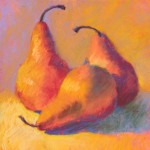I’m writing this sitting in Frankfurt airport as I travel home from my 7-day Croatia workshop. Teaching this workshop got me thinking a lot about negative space – both its power as a visual device and as a tool to aid in the creation of a painting. My demo and lesson on the last day touched on the use of negative space.
Here’s my demo:


When we look at the world, we see it in three dimensions, and we rarely see the space around objects. When we prepare to draw or paint a subject, however, if we are intentional in our looking, we can then see the negative space by which I mean the space in and around objects. In making our marks on a two dimensional surface, the negative space becomes just as important as the positive shapes. Understanding negative space will help you render a subject as well as give your work more impact.
Using negative space to help render your subject
If you’re having difficulty seeing a subject and recording it’s dimensions on paper, examine and draw the space and shapes around it. And when it comes to painting, don’t feel obliged to put down the subject in its perfect and final form from the start. Instead, create shapes that are amorphous. You can then paint the negative space and so doing, ‘carve’ out the subjects as clearly or as vaguely as desired.
Using negative space to make your work more powerful
In carving out the positive shapes, you create hard and soft edges. The balance between these edges help attract and lead the eye. As a visual artist, you cover your surface with a variety of shapes whether positive shapes or negative space. All become important parts of the painting puzzle. They’re abstract shapes that come together to create a visual representation
in a way the speaks of your artistic intention.
Let me take you through another painting I did a couple of days after the demo. (I’m sorry there are so few progress photos – I got immersed in painting and forgot to record more steps!)








Can you see why I’m somewhat obsessed with negative space? I love using this method to create an image!
Do you use negative space as an important part of your painting process and the painting itself? Whether you do or don’t, I’d love to hear from you so please leave comment!
Until next time (when we have a guest blogger who is an artist of roomscapes…!),
Gail
PS. If you wished you could have been on the Croatia workshop, know that I have another painting holiday coming up on the Costa Brava, Spain in early May 2018. Click here for more info.


































6 thoughts on “Improve Your Paintings With The Power Of Negative Space”
I use negative space to carve out positive space. I think the positive shapes are more varied, interesting and dynamic. They also become more complex
Yes you are spot on Audrey! Thanks for adding your voice to the negative space conversation 🙂
Dear Ms.Gail,
Thank you very much for your share, I am a new coming joint your web site but i can see I have a lots of benefit seen I joint your member, I alway confusing with my subject when I drawing but I can see how I can management with my drawing after today.
Again, thank a lots for your share.
Best regards,
Mai Nguyen
Hello Mai,
Many thanks for your comment and for subscribing to HowToPastel. I am glad this blog post will be helpful to you. Along with seeing and simplifying values, looking at negative space really will help with drawing and sorting out the chaos and complexity that you see.
Gail
Thanks for sharing Gail!! Between seeing your step by step and also seeing a post showing work by Mike Beeman showing his step by step, I feel that I HAVE to try both of your techniques!! They will work together very well, I think. By the way, you make me smile. Thanks!!!
Hah hah Ruth that’s wonderful!! Look forward to seeing the results. I’m curious about Mike’s post. You can always add a link here to it.